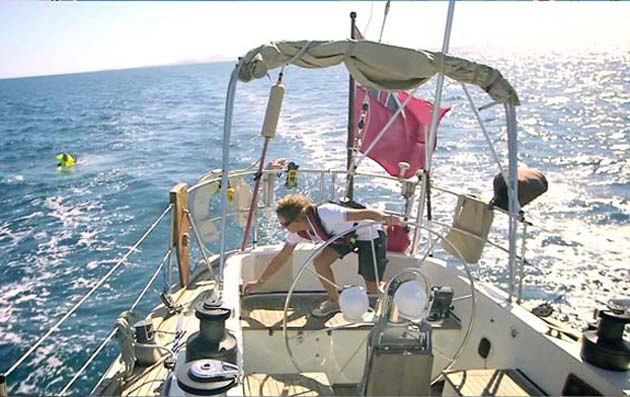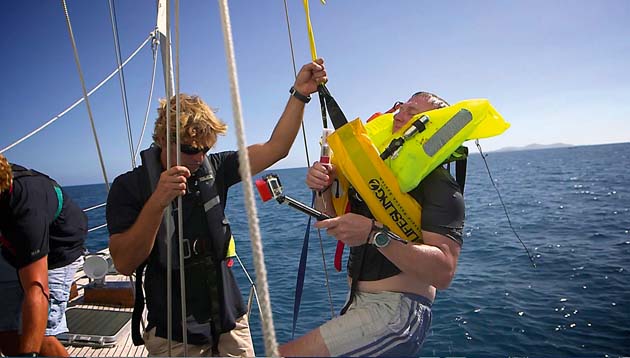It is imperative to practise recovering a casualty from the water before you go ocean cruising and have your recovery kit close to hand, writes Dan Bower
 A man overboard on an ocean passage is probably one of the most terrifying emergencies for the skipper. This is because of the speed with which you can lose control of the situation. Though fortunately a very rare event, it could potentially happen at any time without warning. We once had someone fall in when catching water using a bucket – they forgot to tie it on.
A man overboard on an ocean passage is probably one of the most terrifying emergencies for the skipper. This is because of the speed with which you can lose control of the situation. Though fortunately a very rare event, it could potentially happen at any time without warning. We once had someone fall in when catching water using a bucket – they forgot to tie it on.
Since you can’t be on deck 24/7 you need the fast action of the crew on deck to stop the yacht before you lose sight of the casualty – once this happens you are into a search regime and the painful realisation that locating the person at all is not a certainty. It is with this in mind that a prudent skipper briefs the crew beforehand about the real risks and adopts a sensible approach to lifejackets and clipping on.
But what if the worst happens? In Part 7 we looked at the best way to stop the boat quickly under downwind sails and remain close to the casualty, but that is only half the job. Next you have to get them on board safely. The biggest difficulty here is the sea state – even on a quiet day on the ocean there is significant swell, which will be pitching and rolling the boat when stopped.
A stern bathing platform and associated ladder is going to be completely useless in this situation. The risk of being hit by or swept under the transom is very real, and the physical agility needed for the casualty to get out of the water would be challenge enough with everything in your favour; not a chance for the disoriented/shocked casualty – presumably clothed and probably in a lifejacket.
Getting them back on board
On Skyelark we have a portable safety ladder. It is 2.5m long, made of rope and webbing and we can deploy it anywhere it’s needed along the side of the boat. It needs to be long enough to get a footing even when the boat is rolling, which is surprisingly deep.
We often stop for a mid-ocean swim, but only if there are light winds and the swell is low, and even then it’s noticeable how much the boat rolls and how difficult it is to use our boarding ladder to get on board.
Out of choice we would recover the MOB just abaft the shrouds where the movement should be least and we have a gate in the guardwires, and well away from the propeller. We clip the safety ladder to the jackstays so it can be quickly moved to where it’s needed.
Even with this system you need to be physically able. When considering this article we decided to do a test. Our crew were encouraged to go overboard, dressed for the tropics and wearing lifejackets in the safety and tranquillity of a Pacific lagoon. What we imagined would be child’s play, actually turned out to be a struggle, not least because of the bulky inflated lifejacket.
Harder than expected
The unnerving reality was how difficult it was to make it out on your own, and everyone found it harder than they expected. No doubt a surge of adrenalin would help on the day, but these were perfect conditions and our lesson was the criteria for treating a casualty as unable or unresponsive, which happens earlier than you might think.
For an unresponsive/unable casualty – We carry a helicopter lifting strop so that the MOB can be winched out of the water. Our procedure involves a crewmember in a climbing harness, lowered over the side on a halyard. They ‘catch’ the casualty and manoeuvre the strop around them. The casualty is then winched out on a second halyard and recovered. Simple, right?
Again this is something you should practise; carrying the kit alone is not enough. Each boat is different and an actual drill will show up problem areas –considerations such as: are your halyards actually long enough?; which halyards and winches will you use? Bear in mind that you may have lost your spinnaker halyard if you have ditched the sail.
The crewmember going over the side needs a breastline or two to clip onto the boat so they have their hands free to manhandle the casualty. The casualty needs to be clipped to the boat as soon as possible. This frees the hands of the rescuer to handle the lifting strops and relaxes the MOB (they are secure) and means the helm can be left alone. The lengths of the lines and where they are attached is important, as is the lead through the guardwires so they don’t get caught when the casualty is raised – only practice will sort this out.
Next there is the lifejacket, the rescuing crewmember should be wearing one, but an inflated lifejacket will become real obstacle to their movement and ability to control and assist the MOB. So it might be prudent to have them in a manual lifejacket (or remove the auto firing mechanism, as they are sure to go under the water at some point).
We have a grab bag ready for this situation. It contains the lifting strop, a climbing harness, a manual lifejacket and two different coloured harness lines, one for the MOB and one for the crew – all this is shown in our accompanying video.
Practical notes
Lifting strops – ours is a Lifesling-type device, and one issue with this is that it is buoyant, which makes getting it onto someone in the water quite difficult. However, because of its make-up, it is impossible to get twisted and it’s bulky enough to get a firm grip.
It also is only a single loop so it pulls the casualty vertically out of the water – we are assuming they have not been in the water too long, otherwise there is a risk of post-rescue collapse. If this is a risk, a second rope loop would need to be rigged under their knees to lift them more horizontally, although actually physically getting them into position at sea would be quite an achievement.
We have also found that if the MOB is wearing a lifejacket it is very difficult to manoeuvre the Lifesling over their head and into position. It is easier to get them through feet first, making sure the lifejacket is keeping their head above water, or deflating the lifejacket a little once they are safely clipped on.
The Lifesling method requires a number of people and may not be appropriate for short-handed crews, in which case other procedures may need to be considered. There are MOB recovery systems on the market, but whether they would work in a sea state has, to my mind, not been adequately proven. Clipping on is the only sure way of recovering someone short-handed. At the very least the boat can be stopped, a halyard clipped onto the harness and the casualty hauled out on an electric winch. It may not be painless, but it should be quick and they are on board!
Of course, good seamanship dictates that prevention is better than cure and being clipped on is more likely to reduce the time it takes to recover an MOB. However, there have been instances when being clipped on and dragged behind the boat has been the cause of injury and it is paramount that the yacht is stopped quickly to reduce the chance of drowning. There should always be a knife to hand to cut the tether if required.
Do’s and don’ts
√ Do practise with a real person.
√ Do Do brief all new crew on the procedure and show them the kit.
√ Do Do have a prepared grab bag with everything you need.
√ Do Do keep a sharp knife handy and make sure everyone knows where it is for emergencies.
x Don’t rely on the boat’s standard boarding ladder.
x Don’t be complacent.
Dan and Em Bower
Dan and Em Bower, both in their thirties, are lifelong sailors. Six years ago they bought Skyelark of London, a Skye 51 by American designer Rob Ladd, built in Taiwan in 1986, and have been sailing and chartering her ever since, making some 12 transatlantic crossings and covering around 60,000 miles.
Part 9: Night watches
How best to organise your watch routine to make sure all crew are comfortable, confident and well-rested when they come on deck
See videos for all the parts here
12-part series in association with Pantaenius









